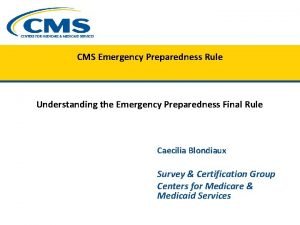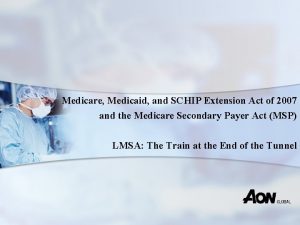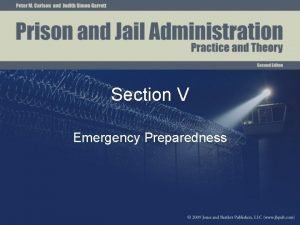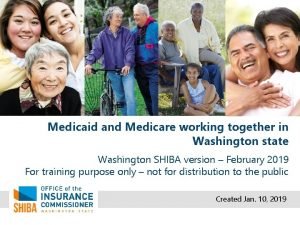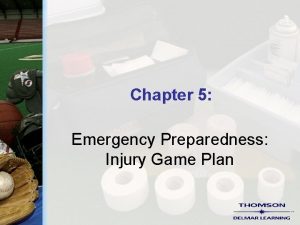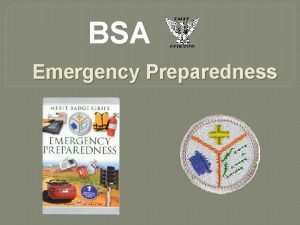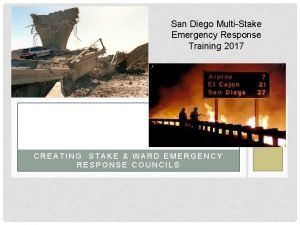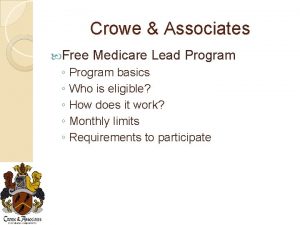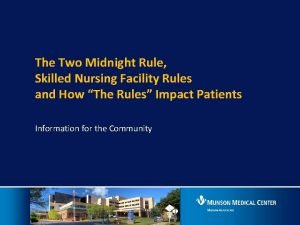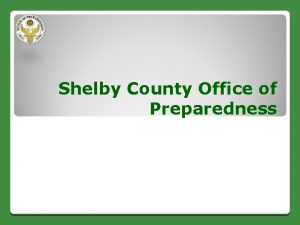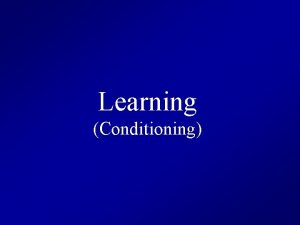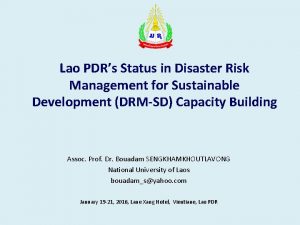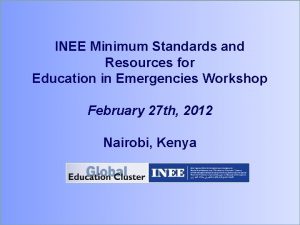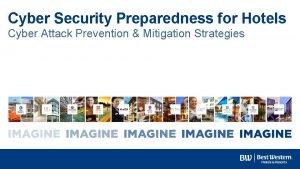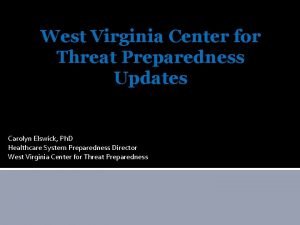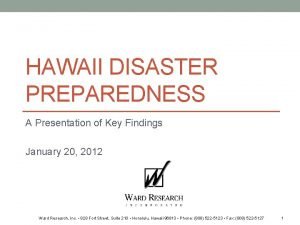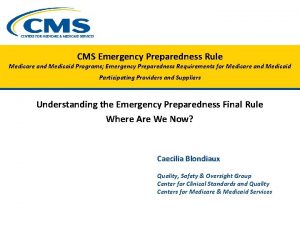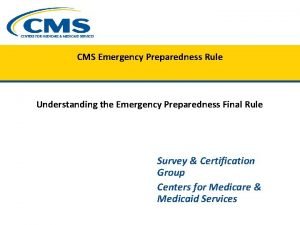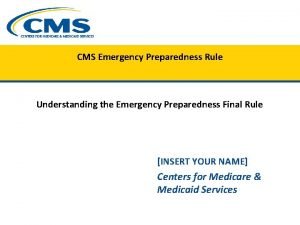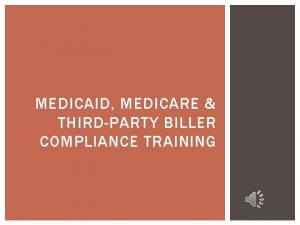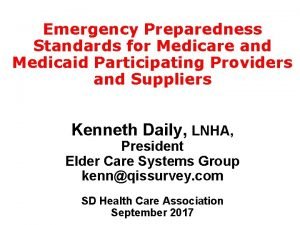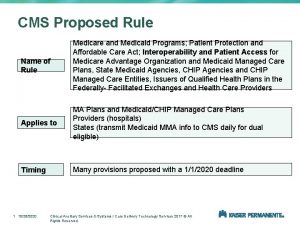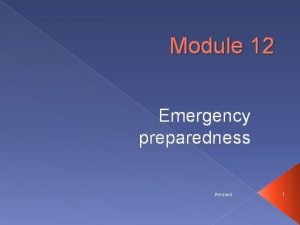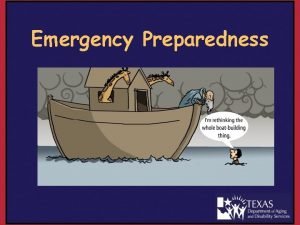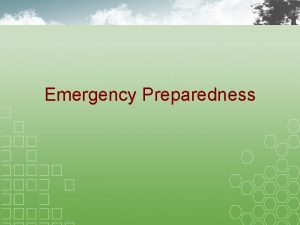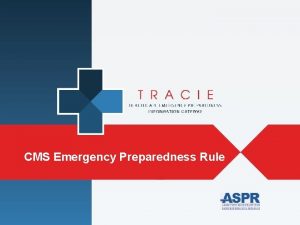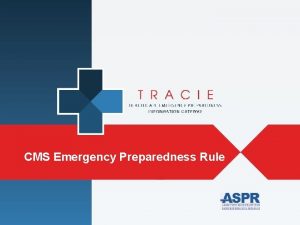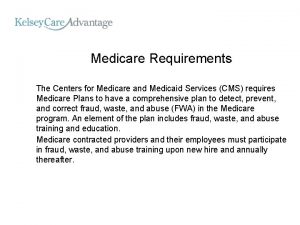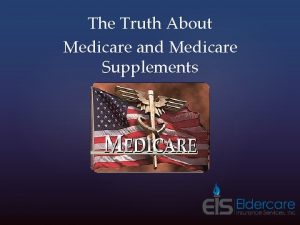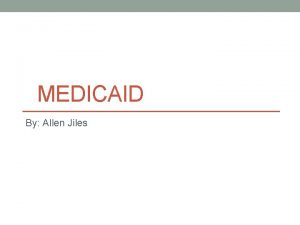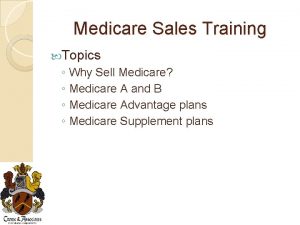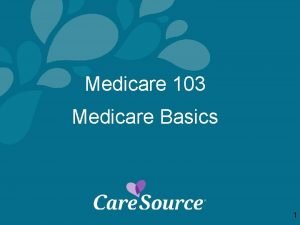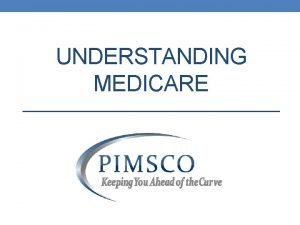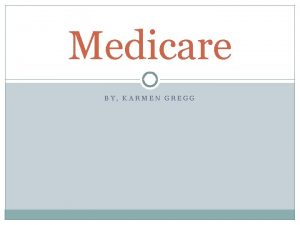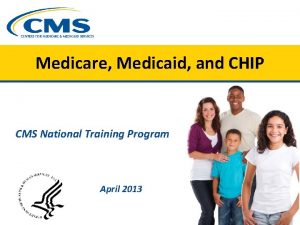CMS Emergency Preparedness Rule Medicare and Medicaid Programs



























- Slides: 27

CMS Emergency Preparedness Rule Medicare and Medicaid Programs; Emergency Preparedness Requirements for Medicare and Medicaid Participating Providers and Suppliers Understanding the Emergency Preparedness Final Rule Where Are We Now? Caecilia Blondiaux Quality, Safety & Oversight Group Center for Clinical Standards and Quality Centers for Medicare & Medicaid Services

Disclaimer This presentation was prepared as a tool to assist providers and is not intended to grant rights or impose obligations. Although every reasonable effort has been made to assure the accuracy of the information within these pages, the ultimate responsibility for the correct submission of claims and response to any remittance advice lies with the provider of services. This publication is a general summary that explains certain aspects of the Medicare Program, but is not a legal document. The official Medicare Program provisions are contained in the relevant laws, regulations, and rulings. Medicare policy changes frequently, and links to the source documents have been provided within the document for your reference The Centers for Medicare & Medicaid Services (CMS) employees, agents, and staff make no representation, warranty, or guarantee that this compilation of Medicare information is error-free and will bear no responsibility or liability for the results or consequences of the use of this guide.

Final Rule • Published September 16, 2016 with an implementation date of November 15, 2017 • Applies to all 17 provider and supplier types • Compliance required for participation in Medicare (and Medicaid, as applicable) • Emergency Preparedness is one new Co. P/Cf. C of many already required • Facilities began being surveyed for the new requirements after November 2017 in conjunction with their existing survey cycles • In the event facilities are non-compliant, the same general enforcement procedures will occur as is currently in place for any other conditions or requirements cited for non-compliance. 3

Four Provisions for All Provider Types Risk Assessment and Planning Policies and Procedures Emergency Preparedness Program Communication Plan Training and Testing 8

What is an All-Hazards Approach: • An all-hazards approach is an integrated approach to emergency preparedness planning that focuses on capacities and capabilities that are critical to preparedness for a full spectrum of emergencies or disasters • Includes internal emergencies; man-made emergencies; and/or natural disaster. • Specific to geographic location of the provider or supplier • These may include, but are not limited to, care-related emergencies, equipment and power failures, interruptions in communications, including cyber-attacks, loss of a portion or all of a facility, and interruptions in the normal supply of essentials such as water and food. 7

General Overview • With the exception of Transplant Programs, that are incorporated under the Transplant Hospital’s Emergency Preparedness Program: • All 17 Providers and Suppliers are required to be in compliance with the four core elements/provisions with variations • Variations may include areas such as: ‒ Accountability for missing residents ‒ Subsistence needs for inpatient providers only ‒ Home health agencies and hospices required to inform officials of patients in need of evacuation

Four Provision Areas At-A-Glance • Risk Assessment and Planning (Annually): ‒ Develop an emergency plan based on a risk assessment. ‒ Perform risk assessment using an “all-hazards” approach, focusing on capacities and capabilities. • Policies and Procedures (Annually): ‒ Develop and implement policies and procedures based on the emergency plan and risk assessment. ‒ Policies and procedures must address a range of issues including subsistence needs, evacuation plans, procedures for sheltering in place, tracking patients and staff during an emergency. 9

Four Provision Areas Continued • Communication Plan (Annually): ‒ Develop a communication plan that complies with both Federal and State laws. ‒ Coordinate patient care within the facility, across health care providers, and with state and local public health departments and emergency management systems • Training & Testing Program (Annually): ‒ Develop and maintain training and testing programs, including initial training in policies and procedures. ‒ Demonstrate knowledge of emergency procedures and provide training at least annually. ‒ Conduct drills and exercises to test the emergency plan 9

Temperature Controls and Emergency and Standby Power Systems • Under subsection (b), “Policies and Procedures, ” are requirements for subsistence needs and temperature controls. • Additional requirements for hospitals, critical access hospitals, and long-term care facilities are located in the applicable section of the regulations under subsection (e), “Emergency Power and Stand-by Systems. ” 13

What has been completed? • In September, 2017, the surveyor training for emergency preparedness requirements was launched. Available at https: //surveyortraining. cms. hhs. gov/ • Training through the Integrated Surveyor Training Website is also available for providers/suppliers. • The website also provides important links to additional resources and organizations who can assist. https: //www. cms. gov/Medicare/Provider-Enrollmentand-Certification/Survey. Cert. Emerg. Prep/index. html

Where are we now? • Surveys began in late November and are being conducted by either health surveyors or Life Safety Code (LSC) surveyors • Surveys are in conjunction with regularly scheduled survey cycles • Limited inquiries in recent months from providers and suppliers on what to do in order to be compliant- good sign!

What do the data show? • Preliminary Data has been pulled through our survey reporting system. . • For example, in pulling data from a State (CA): ‒ Total facilities surveyed between late November to early February (EP eligible facilities) = 1179 ‒ Total number of EP surveys with EP Tags Cited= 311 ‒ 26% of facilities (CA) surveyed were cited for at least one EP Tag.

. What do the data show? . • Largest Number of E-Tags Cited are: ‒ E-004: Emergency Plan ‒ E-013: Policies and Procedures (General) ‒ E-026: Communication Plan (General) ‒ E-036: Training and Testing (General) ‒ E-039: Testing Exercises • As anticipated, one of the most frequent citations has been under the Testing provision of emergency preparedness (d)(2).

Next Steps • CMS will continue to look at the data periodically to see if trends continue in certain areas • CMS is partnering with other agencies to assist in providing additional resources for those areas of concern • Providers can access the training on the Surveyor Website to gain better understanding of the requirements. • Facilities are recommended to work together. Do not re-invent the wheel!

Thank you! SCGEmergency. Prep@cms. hhs. gov

Acronyms in this Presentation • Cf. Cs- Conditions for Coverage • Co. Ps- Conditions for Participation • EP- Emergency Preparedness • IGs- Interpretive Guidelines • TTX- Table Top Exercise 16

Hospital Preparedness Program and the CMS Emergency Preparedness Rule Melissa Harvey

HPP: Response Ready. Community-Driven. Health Care Prepared. • The Hospital Preparedness Program (HPP) is a cooperative agreement administered by ASPR and is the only source of federal funding for health care delivery system readiness • HPP prepares the health care system to save lives during emergencies that exceed day-to-day capacity of the health and emergency response systems. § HPP does this by developing and sustaining regional health care coalitions (HCCs) § HCCs incentivize diverse and often competitive health care organizations with differing priorities and objectives to work together • HPP promotes a sustained national focus on improving patient outcomes, minimizing the need for supplemental state and federal resources during emergencies, and enabling rapid recovery. Saving Lives. Protecting Americans. 18

HPP by the Numbers HPP Cooperative Agreement Funding Allocations $255 million for each fiscal year 2014 -2017 In addition, $249 million awarded specifically for Ebola Not including supplemental appropriations 62 awardees – health departments in all 50 states, the District of Columbia, 3 localities, all U. S. territories and freely associated states (HPP does not directly fund hospitals) 476 HCCs nationwide $498 31, 000 HCC members nationwide $471 $460 $415 $398 $362 98 percent of HPP awardees say that HPP has been critical to health care system preparedness 65+ member HPP stakeholder community of national health care, public health, and emergency management associations $391 $353 $352 $332 $229 $125 2002 2003 2004 2005 2006 2007 2008 2009 2010 2011 2012 2013 2014 2015 2016 2017 Saving Lives. Protecting Americans. 19

Evolution from Facility-Based Equipment to an HCC Capabilities-Based Approach 2002– 2011 2012– 2017 Facility-based equipment purchases Capabilitiesbased approach to planning Personal protective equipment, mobile medical units, pharmaceutical caches, other emergency supplies and equipment HPP funding is used to enhance health care system planning and response at the state, local, regional, and territorial levels • Foundation for Health Care and Medical Readiness • Health Care and Medical Response Coordination • Continuity of Health Care Service Delivery • Medical Surge Saving Lives. Protecting Americans. 20

HCCs: Coordinating a Regional Approach to Health Care and Medical Response An HCC is a group of individual health care and response organizations in a defined geographic location. HCCs play a critical role in developing health care preparedness and response capabilities. Saving Lives. Protecting Americans. 21

HCCs Have Diverse and Growing Membership There are over 31, 000 HCC members nationwide, a 92 percent increase from 2012. * HCC Core Members Hospitals - 85% Local Health Departments - 82% Emergency Management Agencies - 56% Emergency Medical Services - 27% Skilled Nursing Facilities - 29% Federally Qualified Health Centers - 29% Psychiatric Residential Treatment Facilities - 19% End Stage Renal Disease Dialysis Clinics - 18% Hospices - 16% Community Health Centers - 15% BP 1 HCC Members Rural Health Clinics - 15% BP 2 -BP 5 HCC Member Change from BP 1 Community Mental Health Centers - 14% BP 5 Non-HCC Members Ambulatory Surgical Centers - 10% Home Health Agencies - 5% 0 5 000 10 000 Saving Lives. Protecting Americans. 15 000 20 000 22

Critical Role of HCCs in Successful Preparedness and Response Efforts Republican National Convention Hurricane Harvey Passenger Train Derailment • Northeast Ohio Regional HCC • Coordinated surge support with 27 medical facilities • Regularly surveyed health care facilities to ensure inventories of specialized equipment, contact information, blood inventories, and bed availability were up-to-date in preparation for over 20, 000 Convention visitors • South. East Texas Regional Advisory Council (SETRAC) HCC • Coordinated effectively across Houston’s health care system using emergency management systems and communication • Operated catastrophic medical operations center to manage safe hospital evacuations and patient transfers • Washington state’s Northwest Healthcare Response Network • HCC activated the HPP-funded patient-tracking system within an hour of the event, facilitating the distribution of 70 patients to nine hospitals across two counties • Reconciled the passenger manifest with the patient tracking system within 24 hours Saving Lives. Protecting Americans. 23

The New CMS Emergency Preparedness Rule Creates Exciting Opportunities for HCCs The new CMS rule offers HCCs and newly engaged providers a tremendous opportunity to achieve greater organizational and community effectiveness and financial sustainability. • HPP anticipates that health care entities that have not previously engaged in community preparedness will seek to do so through participation in HCCs • HCCs will function as an accessible source of preparedness and response best practices as newly engaged provider types adapt to the new requirements • HPP funding may not be used by individual health care organizations to meet the requirements of the CMS rule, but may be used by HCCs to provide technical assistance to their members Saving Lives. Protecting Americans. 24

ASPR TRACIE Provides Support for the CMS Emergency Preparedness Rule • Dedicated CMS Rule page: ASPRtracie. hhs. gov/CMS rule • “CMS Emergency Preparedness Rule: Resources at Your Fingertips” document § Provides description of each of the 17 supplier and provider types affected by rule § Includes requirements crosswalk table • ASPR TRACIE’s Topic Collections and Provider- and Supplier-Specific resources can help organizations involved in implementing the CMS requirements with resources tailored to their specific needs • Assistance Center support (all regulatory or compliance questions can only be answered by CMS) Saving Lives. Protecting Americans. 25

CMS Rule Health Sector Emergency Preparedness Course The Center for Domestic Preparedness (CDP) at FEMA is offering a Health Sector Emergency Preparedness Course that will provide healthcare providers and suppliers with training in achieving the four core emergency preparedness elements outlined in the CMS Rule. • Course Goals: Understand specific emergency preparedness requirements as outlined in the CMS Rule and develop knowledge and skill in achieving these requirements. • Course Length: 8 hours • Course Delivery Means: Non-resident at a coordinated host location • Course Host Responsibilities: § Provide a classroom or auditorium capable of seating the expected audience § Support recruitment of an appropriate audience from the 17 CMS identified providers and suppliers § Provide a point of contact to coordinate the class(es) with the FEMA Center for Domestic Preparedness Non-Resident Training Coordinator Saving Lives. Protecting Americans. 26

Questions? Saving Lives. Protecting Americans. 27
 Cms emergency preparedness requirements by provider type
Cms emergency preparedness requirements by provider type Medicare set-aside flow chart
Medicare set-aside flow chart Chapter 36 emergency preparedness and protective practices
Chapter 36 emergency preparedness and protective practices Chapter 36 emergency preparedness and protective practices
Chapter 36 emergency preparedness and protective practices Medicare vs medicaid washington state
Medicare vs medicaid washington state Bloody sunday apush
Bloody sunday apush Chapter 5 emergency preparedness injury game plan
Chapter 5 emergency preparedness injury game plan Bsa emergency preparedness
Bsa emergency preparedness National radiological emergency preparedness conference
National radiological emergency preparedness conference Stake emergency preparedness plan
Stake emergency preparedness plan Medicare lead programs
Medicare lead programs Two midnight rule
Two midnight rule Overview of software engineering
Overview of software engineering What are disasters
What are disasters Dog bite pictures
Dog bite pictures Shelby county office of preparedness
Shelby county office of preparedness Insight learning theory
Insight learning theory Conditioning learning
Conditioning learning Conclusion in disaster management
Conclusion in disaster management Preparedness mitigation response recovery
Preparedness mitigation response recovery Biological preparedness
Biological preparedness Do. 27 s. 2015 promoting family earthquake preparedness
Do. 27 s. 2015 promoting family earthquake preparedness Hotel cyber security
Hotel cyber security 1achors
1achors West virginia center for threat preparedness
West virginia center for threat preparedness Who pip framework
Who pip framework Implementing nfpa 1600 national preparedness standard
Implementing nfpa 1600 national preparedness standard Hawaii disaster preparedness
Hawaii disaster preparedness
